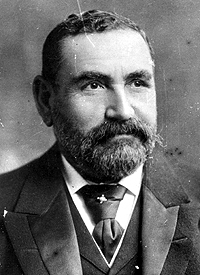See ministry | |
|---|---|
30th Cabinet of the State of New South Wales | |
 | |
| Date formed | 28 March 1901 |
| Date dissolved | 14 June 1904 |
| People and organisations | |
| Monarch | Edward VII |
| Governor | The Earl Beauchamp / Sir Harry Rawson |
| Premier | Sir John See |
| No. of ministers | 12 |
| Member party | Progressive |
| Status in legislature | Minority government |
| Opposition party | Liberal Reform |
| Opposition leader | Charles Lee (1901–1902) Joseph Carruthers (1902–1904) |
| History | |
| Election | 1901 New South Wales election |
| Outgoing election | 1904 New South Wales election |
| Predecessor | Lyne ministry |
| Successor | Waddell ministry |
The See ministry was the 30th ministry of the New South Wales Government, and was led by the 14th Premier, Sir John See.[a] The title of Premier was widely used to refer to the Leader of Government, but was not a formal position in the government until 1920. Instead the Premier was appointed to another portfolio, usually Colonial Secretary.
See was elected to the New South Wales Legislative Assembly in 1880 as member for Grafton, serving in the Dibbs and Lyne ministries, prior to assuming leadership of the Progressive Party.
Under the constitution, ministers in the Legislative Assembly were required to recontest their seats in an election when appointed.[2] Such ministerial by-elections were usually uncontested and on this occasion there were only three new ministers, Robert Fitzgerald, John Kidd and Thomas Waddell and all were re-elected unopposed.[3] Fitzgerald was defeated at the 1901 election for Robertson and was not replaced as Minister of Justice with Bernhard Wise KC, the Attorney General, taking on the additional responsibilities. Hugh Pollock, the secretary of the Attorney General's Department, was appointed as a non-political Solicitor General to assist the Attorney General by taking responsibility for committal proceedings.[4] Pollock's appointment was controversial because he was a public servant and had never practiced as a barrister.[5] Francis Suttor was appointed President of the Legislative Council in 1903 and was replaced in the ministry by Kenneth Mackay.[6]
This was the first occasion in which ministers were appointed to the Executive Council (or cabinet) without responsibility for a department or portfolio.[7] It was initially 2 ministers James Hayes,[8] and Walter Bennett,[9] with John Fegan added in 1903.[10] They were not paid in addition to their allowance as a member of parliament,[b] did not have an "office of profit" and were not required to recontest their seats at a by-election.[7]
The ministry covers the period from 28 March 1901 until 14 June 1904,[6] when failing health and the death of his wife in March 1904 compelled him to retire.[13][1] See was succeeded by his Progressive Party colleague, Thomas Waddell.[6]

- ^ a b Henry, Keith. "See, Sir John (1845–1907)". Australian Dictionary of Biography. Canberra: National Centre of Biography, Australian National University. ISBN 978-0-522-84459-7. ISSN 1833-7538. OCLC 70677943. Retrieved 10 July 2021.
- ^ Twomey, Anne (2004). The Constitution of New South Wales. Federation Press. pp. 442. ISBN 9781862875166. Retrieved 24 November 2020.
- ^ Green, Antony. "1898 to 1901 by-elections". New South Wales Election Results 1856-2007. Parliament of New South Wales. Retrieved 10 July 2021.
- ^ "State politics: the vacant portfolio". The Sydney Morning Herald. 9 July 1901. p. 5. Retrieved 14 July 2021 – via Trove.
- ^ Mason, K (2019). "Ch 1 Aspects of the History of the Solicitor-General in Australia". In Keyzer, P; Patrick (eds.). Public Sentinels: A Comparative Study of Australian Solicitors-General. Routledge. ISBN 9781317073338. Retrieved 19 January 2019.
- ^ a b c "Part 6 Ministries since 1856" (PDF). NSW Parliamentary Record. Parliament of New South Wales. Retrieved 4 March 2020.
- ^ a b "The state ministry". The Daily Telegraph. 12 April 1901. p. 6. Retrieved 10 July 2021 – via Trove.
- ^ "Appointments to the Executive Council". Government Gazette of the State of New South Wales. No. 301. 11 April 1901. p. 2981. Retrieved 10 July 2021 – via Trove.
- ^ "Appointment to the Executive Council". Government Gazette of the State of New South Wales. No. 320. 16 April 1901. p. 3135. Retrieved 10 July 2021 – via Trove.
- ^ "Appointment to the Executive Council". Government Gazette of the State of New South Wales. No. 158. 24 March 1903. p. 2419. Retrieved 11 July 2021 – via Trove.
- ^ Parliamentary Representatives Allowance Act 1889 (NSW).
- ^ Clune, David & Griffith, Gareth (2006). Decision and Deliberation. pp. 31-32. ISBN 9781862875913. Retrieved 11 July 2021.
- ^ Serle, Percival (1949). "See, Sir John (1844–1907)". Dictionary of Australian Biography. Sydney: Angus & Robertson. Retrieved 22 August 2011.
Cite error: There are <ref group=lower-alpha> tags or {{efn}} templates on this page, but the references will not show without a {{reflist|group=lower-alpha}} template or {{notelist}} template (see the help page).